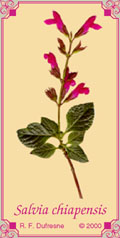Salvia chamaedryoides
|
![]()
Links to Other World of Salvia Pages:
 |
Germander Sage This relative of Salvia greggii has bright medium blue flowers that contrast with gray-green foliage in an upright bush that sprawls a bit. It is tolerant of sub-tropical conditions but thrives in Mediterranean climates. Only S. lycioides is hardier. There are larger flowered forms than this one, including an accession from Yucca-Do. All other members in section Flocculosae might be expected to have the same flower color. Exceptions, even those described in the literature, may be hybrids with S. greggii. Further study of collected material is warranted. See the entry for S. coahuilensis for further discussion. ©2000 by Richard F. Dufresne |
 |
Chiapas Sage This species forms beds of glossy foliage to about one foot high with elongated spikes of fuchsia flowers. As hinted by its foliage, this is a plant that can take both sun and shade, and does well in subtropical humidity. It is half-hardy for me in Greensboro. Collected by Dr. Dennis Breedlove of the Strybing Arboretum, it has been in the California trade for some time. It is a possible mystery parent of both Salvia leucantha aff. `Waverly’ and S. involucrata x `Mulberry Jam’. ©2000 by Richard F. Dufresne |
 |
Indigo Purple Autumn Sage One of the interesting section Flocculosae, this plant has the green, glossy foliage of Salvia greggii and sprawls a bit, but not to the extreme of its bluer-flowered relative S. chionophylla. As with the blue to purple members of this group, the flowers are smaller. Flower size is frequently larger in proportion to the degree of redness of the flower color. Another trend seems to be the relative hardiness, which increases in plants with more red-hued flowers. The intense indigo-blue color of this species can be obtained by mixing the sky-blue color of S. chionophylla with the red of S. greggii. My accession of S. coahuilensis was collected by Manuel Flores and is not hardy for me. It seems to prefer Mediterranean conditions. ©2000 by Richard F. Dufresne |
 |
`Dark Dancer' Autumn Sage Dark Dancer has extra-large flowers for either a Salvia greggii or a S. microphylla. The flower color is identical to that of Raspberry Royale, and is really a deep magenta or fuchsia. When lightened, the color is the same as in many S. microphylla forms, and lightened even more, it is the color of most pink forms of these two species. This sun-lover grows into an erect shrub. It can reach an appreciable size in one year, making it a candidate as an annual in cooler parts of the United States as well as a good Mediterranean subject. It also tolerates humidity pretty well. One of an increasing number of hybrids coming from California, this plant was discovered as a chance seedling in the nursery of M. Nevin Smith, now at Suncrest Nurseries. The distinctive undulating margin of its foliage may be a clue to one of its parents. ©2000 by Richard F. Dufresne |
 |
`Raspberry Royale' `Raspberry Royale' Texas Sage Raspberry Royale is a sport that appeared in my garden around 1984. It is a likely cross of the white flowered form of S. greggii I got from Carroll Abbott of Kerrville, Texas and an accession of S. lemmonii (S. microphylla var. Wislizenii) from Southwest Native Seeds. It has proven to be one of my best releases. Besides being a dense bloomer, it seems to be relatively hardy and durable. With little more than an annual trim or two and occasional fertilization, plants have lived longer than five years. It grows rapidly enough to be useful as an annual in the northern parts of the United States, and handles humidity better than other forms. ©2000 by Richard F. Dufresne |
 |
La Trinidad Littleleaf Sage A collection of Yucca-Do, this shrub is a typical littleleaf sage, growing vigorously into a man-sized bush under ideal conditions. It is somewhat rhizomatous, but is not invasive. Like almost all S. microphylla forms, it handles subtropical conditions better than S. greggii forms. This makes it a good candidate for the more warm and humid parts of the United States. It also grows well enough to be treated as an annual in colder areas. It is a robust grower in Mediterranean areas. ©2000 by Richard F. Dufresne |
Links to Other World of Salvia Pages:
![]()
|
Salvia chamaedryoides
|